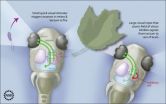(Press-News.org) Between alerting us to danger and allowing us to spot prey, vision keeps many animals, including humans, alive. But exactly how does this important sense work, and why is it easier for us to spot movement of small objects in our field of vision, than to notice other things? The complexity of the neural network that supports vision has long baffled scientists.
Now, with a new technology and support from the National Science Foundation, Claire Wyart in Ehud Isacoff's lab at the University of California at Berkeley and Filo Del Bene at Herwig Baier's lab at the University of California at San Francisco have been able to follow entire populations of retinal and brain cells in their test animal: the zebrafish larva, and solve some of the mysteries of its neural circuit that underlies its vision.
The research team's findings were published in the October 29 issue of Science.
Using a newly developed genetically encoded fluorescent reporter of neural activity developed by Loren Looger at the Howard Hughes Medical Institute's Janelia Farm Research Campus, Wyart and Del Bene have been able to follow how large and small visual cues translate into electrical activity in a region of the zebrafish's brain.
The brain region of the zebrafish that receives input from the retina, called the optic tectum, is separated into layers. The top layer receives direct connections from retinal cells, and has a population of both excitatory and inhibitory neurons. These neurons connect to output neurons that project to other brain regions that control how the zebrafish chases prey.
Isacoff, Baier, Wyart and Del Bene have revealed that a large visual stimulus covering the entire field of vision (such as large floating debris, or another zebrafish) results in low output neuron activity. However small (prey-sized) items moving across the zebrafish's field of vision at a prey-like speed activate the output neurons very well. The basis of this "filtering" of information is that large visual stimuli massively activate the inhibitory cell population and inhibit the output cells, while small moving objects activate only a small number the inhibitory tectal cells, enabling the excitation to drive the output cells efficiently.
This mechanism gives the zebrafish good hunting responses to appropriate visual cues, and thereby helps keep it from biting off more than it can chew.
Isacoff and Baier demonstrated that the inhibition of neural activity by large visual stimuli is essential for hunting prey--as evidenced by the fact that prey capture was disrupted when the inhibitory cells were removed or prevented from emitting neurotransmitters.
INFORMATION:
The zebrafish's neural circuit prevents it from biting off more than it can chew
Inhibiting certain brain cells sharpens animal's response to small and quick visual stimuli
2010-11-02
ELSE PRESS RELEASES FROM THIS DATE:
New data from Phase 3 studies showed superior SVR (viral cure) rates achieved with telaprevir-based combination therapy in people with hepatitis C, regardless of race or stage of liver disease
2010-11-02
Boston, MA, October 30, 2010 – Vertex Pharmaceuticals Incorporated (Nasdaq: VRTX) today announced new data from its Phase 3 studies of people with genotype 1 chronic hepatitis C who have not been treated previously. In these studies, the majority of people achieved superior sustained viral response (SVR or viral cure) rates with a telaprevir-based combination regimen, compared to current therapies, regardless of race/ethnicity or stage of liver fibrosis (factors known to limit response to current hepatitis C treatments). Patients in the ADVANCE and ILLUMINATE studies were ...
Study improves accuracy of models for predicting ozone levels in urban areas
2010-11-02
A team of scientists has, for the first time, completely characterized an important chemical reaction that is critical to the formation of ground-level ozone in urban areas. The team's results indicate that computer models may be underestimating ozone levels in urban areas during episodes of poor air quality (smoggy days) by as much as five to 10 percent.
Ground level ozone poses significant health hazards to people, animals and plants; is the primary ingredient of smog; and gives polluted air its characteristic odor. It is known that even small increases in ozone concentrations ...
A discovery could be important for the therapy of lymphoma and leukemia
2010-11-02
A recent scientific discovery made by researchers at the Institut de recherches cliniques de Montréal (IRCM) led by Dr. Javier Marcelo Di Noia, Director of the Mechanisms and Genetic Diversity research unit, was published online today by The Journal of Experimental Medicine. The team identified a mechanism regulating activation-induced deaminase (AID), which could be important for the therapy of some types of lymphoma and leukemia.
AID is a B-lymphocyte enzyme that creates deliberate mutations in the DNA encoding antibodies, which helps produce an appropriate immune ...
Research explores lung cancer among pediatric cancer patients
2010-11-02
Because primary lung adenocarcinoma is exceedingly rare in the pediatric population, it is difficult to properly classify certain lung tumors in children and adolescents. While anecdotal reports of pediatric patients with lung cancer lesions exist, little research has been conducted to link the disease in children to similar pulmonary malignancies in adults. Through an assessment of clinical, tissue-based and molecular data for pediatric lung cancer, research published in the November edition of the Journal of Thoracic Oncology determined that pulmonary lesions found in ...
VIMS scientists help solve mystery of 'alien pod'
2010-11-02
Tracy Collier, an employee at Home Technologies in Newport News, Virginia, was walking her employer's Westie around the Center's manmade lake on Thursday when she saw a large, mysterious blob floating in the water.
Co-worker Charlie Schmuck says "The lake is behind our office. Tracy was walking by the lake, saw the object, and asked everyone else to come out and take a look."
Tracy thought it was "a huge dead snake."
Charlie thought it "looked like some weird underwater fungus, like the ones that explode when you poke them."
Perhaps because it was just a few days ...
ACP's response to the IOM's report the future of nursing: Leading change, advancing health
2010-11-02
The Institute of Medicine (IOM) recently released a study, The Future of Nursing: Leading Change, Advancing Health. The report calls for new and expanded roles for nurses in a redesigned health care system. It recommends improving education for all nurses and allowing nurses to practice to the full extent of their license and ability. It advocates overhauling state scope of practice acts and suggests that advanced practice registered nurses (APRNs) -- certified registered nurse anesthetists, certified nurse-midwives, clinical nurse specialists, and certified nurse practitioners ...
Autism Consortium 2010 Symposium: New therapeutics focus, family resource guide announced
2010-11-02
Boston – November 1, 2010 – The Autism Consortium, an innovative Boston area collaboration of researchers, clinicians, funders and families dedicated to catalyzing research and enhancing clinical care for autism spectrum disorders (ASDs), announced that it will begin a new initiative on Translational Medicine and Autism Therapeutics. The new focus was introduced at the Consortium's fifth annual symposium held October 26th, 2010, at Harvard Medical School in Boston.
"As scientists are starting to connect genetics to brain function and behavior, we believe it is time ...
Grasses have potential as alternate ethanol crop, Illinois study finds
2010-11-02
CHAMPAIGN, Ill. — Money may not grow on trees, but energy could grow in grass. Researchers at the University of Illinois have completed the first extensive geographic yield and economic analysis of potential bioenergy grass crops in the Midwestern United States.
Demand for biofuels is increasing as Americans seek to expand renewable energy sources and mitigate the effects of fluctuating energy prices. Corn ethanol is the main biofuel on the market, but demand for ethanol competes with corn's availability as a food, and rising ethanol consumption could lead to higher food ...
Of 50,000 small molecules tested to fight cancer, 2 show promise
2010-11-02
BOSTON (3:00 p.m. ET, November 1, 2010) — A class of compounds that interferes with cell signaling pathways may provide a new approach to cancer treatment, according to a study published online this week in the Proceedings of the National Academy of Sciences (PNAS) Early Edition. The compounds, called PITs (non-phosphoinositide PIP3 inhibitors), limited tumor growth in mice by inducing cell death.
"PITs cause cells to self-destruct by interfering with the signaling pathways that regulate cell survival. As compounds that promote cell death, PITs show promise in halting ...
Anger makes people want things more
2010-11-02
Anger is an interesting emotion for psychologists. On the one hand, it's negative, but then it also has some of the features of positive emotions. For a new study published in Psychological Science, a journal of the Association for Psychological Science, researchers find that associating an object with anger actually makes people want the object—a kind of motivation that's normally associated with positive emotions.
People usually think of anger as a negative emotion. You're not supposed to get angry. But anger also has some positive features. For example, it activates ...
LAST 30 PRESS RELEASES:
Heart-brain connection: international study reveals the role of the vagus nerve in keeping the heart young
Researchers identify Rb1 as a predictive biomarker for a new therapeutic strategy in some breast cancers
Survey reveals ethical gaps slowing AI adoption in pediatric surgery
Stimulant ADHD medications work differently than thought
AI overestimates how smart people are, according to HSE economists
HSE researchers create genome-wide map of quadruplexes
Scientists boost cell "powerhouses" to burn more calories
Automatic label checking: The missing step in making reliable medical AI
Low daily alcohol intake linked to 50% heightened mouth cancer risk in India
American Meteorological Society announces Rick Spinrad as 2026 President-Elect
Biomass-based carbon capture spotlighted in newly released global climate webinar recording
Illuminating invisible nano pollutants: advanced bioimaging tracks the full journey of emerging nanoscale contaminants in living systems
How does age affect recovery from spinal cord injury?
Novel AI tool offers prognosis for patients with head and neck cancer
Fathers’ microplastic exposure tied to their children’s metabolic problems
Research validates laboratory model for studying high-grade serous ovarian cancer
SIR 2026 delivers transformative breakthroughs in minimally invasive medicine to improve patient care
Stem Cell Reports most downloaded papers of 2025 highlight the breadth and impact of stem cell research
Oxford-led study estimates NHS spends around 3% of its primary and secondary care budget on the health impacts of heat and cold in England
A researcher’s long quest leads to a smart composite breakthrough
Urban wild bees act as “microbial sensors” of city health.
New study finds where you live affects recovery after a hip fracture
Forecasting the impact of fully automated vehicle adoption on US road traffic injuries
Alcohol-related hospitalizations from 2016 to 2022
Semaglutide and hospitalizations in patients with obesity and established cardiovascular disease
Researchers ‘listen in’ to embryo-mother interactions during implantation using a culture system replicating the womb lining
How changing your diet could help save the world
How to make AI truly scalable and reliable for real-time traffic assignment?
Beyond fragmented markets: A new framework for efficient and stable ride-pooling
Can shape priors make road perception more reliable for autonomous driving?
[Press-News.org] The zebrafish's neural circuit prevents it from biting off more than it can chewInhibiting certain brain cells sharpens animal's response to small and quick visual stimuli


